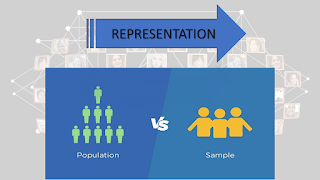POPULATION1
Concept of Population and Sample
In
statistics, population is the entire set of items from which you draw data for
a statistical study. It can be a group of individuals, a set of items, etc. It
makes up the data pool for a study.
Population
It
includes all the elements from the data set and measurable characteristcs of
the population such as mean and standard deviation are known as a parameter.
For example, all people living in
India indicates the population of lndia.
Population and sample are represented in Figure 1
Types of Population
· Finite
Population
· lnfinite
Population
· Existent
Population
· Hypothetical
Population
Finite Population : The existing population is
defined as the population of concrete individuals. In other words, the
population whose unit is available in solid form is known as existent
population. Examples are books, students etc.
Infinite population :The infinite population is also
known as an uncountable population in which the counting of units in the
population is not possible. Example of an infinite population is the number of
germs in the patient’s body is uncountable.
Existing Population : The existing population is
defined as the population of concrete individuals. In other words, the
population whose unit is available in solid form is known as existent
population. Examples are books, students etc.
Hypothetical Population : The population in which
whose unit is not available in solid form is known as the hypothetical
population. A population consists of sets of observations, objects etc that are
all something in common. In some situations, the populations are only hypothetical.
Examples are an outcome of rolling the dice, the outcome of tossing a coin.
Generally,
population refers to the people who live in a particular area at a specific
time. But in statistics, population refers to data on your study of interest.
It can be a group of individuals, objects, events, organizations, etc. You use
populations to draw conclusions.
An
example of a population would be the entire student body at a school. It would
contain all the students who study in that school at the time of data
collection. Depending on the problem statement, data from each of these
students is collected. An example is the students who speak Hindi among the
students of a school.
For
the above situation, it is easy to collect data. The population is small and
willing to provide data and can be contacted. The data collected will be
complete and reliable.
If
you had to collect the same data from a larger population, say the entire
country of India, it would be impossible to draw reliable conclusions because
of geographical and accessibility constraints, not to mention time and resource
constraints. A lot of data would be missing or might be unreliable.
Furthermore, due to accessibility issues, marginalized tribes or villages might
not provide data at all, making the data biased towards certain regions or
groups.
Sample
A
sample is defined as a smaller and more manageable representation of a larger
group. A subset of a larger population that contains characteristics of
that population. A sample is used in statistical testing when the
population size is too large for all members or observations to be included in
the test.
The
sample is an unbiased subset of the population that best represents the whole
data.
The
process of collecting data from a small subsection of the population and then
using it to generalize over the entire set is called samlping
Samples
are used when :
- The population is too large to collect
data.
- The data collected is not reliable.
- The population is hypothetical and is
unlimited in size. Take the example of a study that documents the results
of a new medical procedure. It is unknown how the procedure will affect
people across the globe, so a test group is used to find out how people
react to it.
A
sample should generally :
- Satisfy all different variations present
in the population as well as a well-defined selection criterion.
- Be utterly unbiased on the properties of
the objects being selected.
- Be random to choose the objects of study
fairly.
Types
of Sampling.
· Probability
sampling
· Non-probability
sampling
Probability Sampling :In probability sampling, the
population units cannot be selected at the discretion of the researcher. This
can be dealt with following certain procedures which will ensure that every
unit of the population consists of one fixed probability being included in the
sample. Such a method is also called random sampling.
Some of the techniques used for probability
sampling are:
Simple
random sampling
Cluster
sampling
Stratified
Sampling
Disproportionate
sampling
Proportionate
sampling
Optimum
allocation stratified sampling
Multi-stage
sampling
Non Probability Sampling :In non-probability sampling, the
population units can be selected at the discretion of the researcher. Those
samples will use the human judgements for selecting units and has no
theoretical basis for estimating the characteristics of the population.
Some
of the techniques used for non-probability sampling are:
Quota
sampling
Judgement
sampling
Purposive
sampling
Comparison
of Population and Sample Given Below
|
Comparison |
Population |
Sample |
|
Meaning |
Collection
of all units or elements that possess common characteristics |
A
subgroup of the members of the population |
|
Includes |
Each and
every element of a group |
Only
includes a handful of units of population |
|
Characteristics |
Parameter |
Statistic |
|
Data
Collection |
Complete
enumeration or census |
Sampling
or sample survey |
|
Focus |
Identification
of the characteristics |
Making
inferences about the population |
Click to open


Comments
Post a Comment